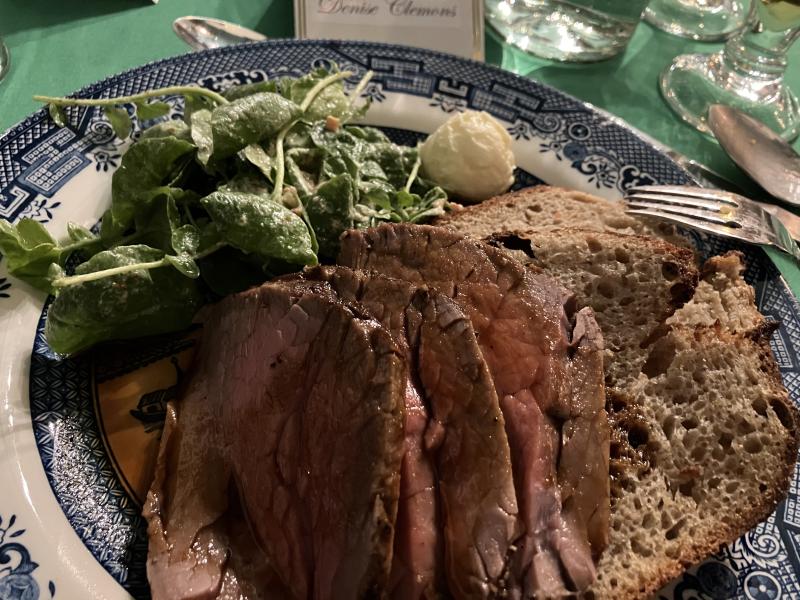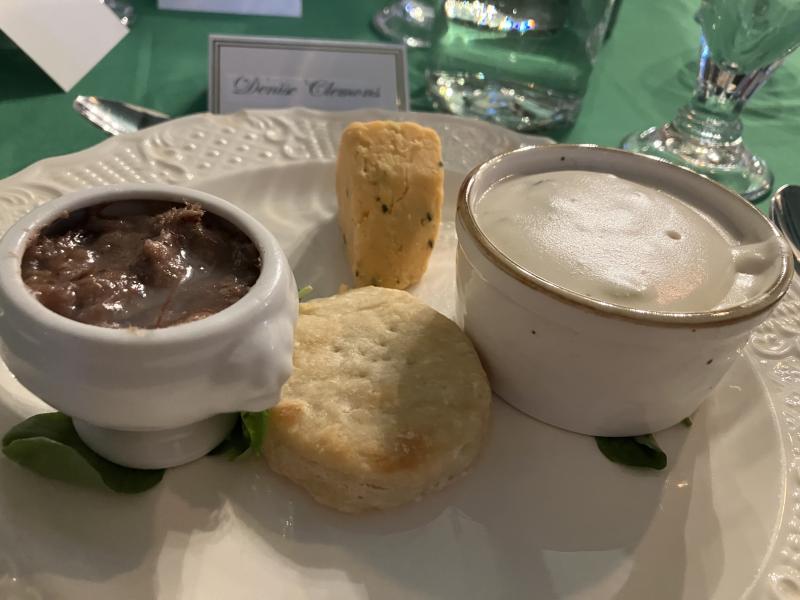Trafalgar Night guests enjoy period dishes in memory of Royal Navy hero
Earlier this week, I attended a ceremonial dinner honoring the success of the British Navy at the Battle of Trafalgar in 1805. Hosted by the Lewes Historical Society, the event followed traditions that have been in place since the original celebration for the famous naval victory and sad anniversary of the death of revered British Royal Navy leader, Vice Admiral Lord Nelson.
The Burton-Ingram House was decorated with several prominently displayed Union Jacks, and the dining room was arranged to resemble an officers mess aboard ship. Although sounding a bit casual, the term “mess” originated as a reference to liquid food, such as soup or stew, and eventually became the term for food in general or food for one meal. The officers mess was the private dining space for the higher-ranking crew members.
And, to follow tradition, many of the attendees were dressed in authentic British Royal Navy uniforms, while others were in tuxedos, one in a kilt and the women wore period dresses or elegant gowns. The serving staff were attired in jackets and breeches, with knotted neckerchiefs to catch any perspiration as they hurried about delivering food and drink. The call to silence was a pounding gavel or stomping boots, which effectively quieted the group.
After cocktails in the parlor, the evening was announced by Midshipman Ryan, whose job it was to advise us of the rules: Your name would be called to be escorted to the table, don’t sit when you get to your seat, and any infractions would incur a fine. The list of infractions included 13 acts, from delaying the movement of the bottle of Port wine going around the table to heckling the speakers to the use of “Satan’s Technology.” As you may imagine, the fines came fast and furiously.
The menu was created by Ian Crandall, executive chef at Kindle restaurant in Lewes. His research into foods of the period led him to discover the work of Othello Pollard, a well-known, Boston-based, African American chef working during the early 1800s. He began selling food to Harvard College students before opening his restaurant, the Classic Hotel, where his “bills of fare” listed the elegant dishes on his menu.
Ian and his team prepared a meal that incorporated several elements of the time and place for the Trafalgar Dinner. The first course included oyster stew, potted lamb and Cotswold cheese with beaten biscuits. During the time before refrigeration, the technique of “potting” meat was a form of preservation, covering it with fat and seasonings, and storing it in small jars. Beaten biscuits were made without chemical leavening, relying on the beating and folding of the dough to create air pockets.
The main course was sliced beef, a familiar dish of the era often served at large gatherings, along with a salad of cress and slices of whole-wheat sourdough made from a decades-old starter. Dessert was Pear Charlotte – ramekins filled with tender slices of pears surrounded by a cake-like crust of brioche bread served with pitchers of crème anglaise.
By now, the bottles of Port had circulated a few times, and between courses the key officers had read (in formal fashion) the dispatches originally written during the battle. Throughout the meal, the voices of Midshipman Ryan and Lieutenant Lyter called out infractions. After the final toast to the “Immortal Memory” of Nelson, the evening ended with an invitation to retire to the Sussex Tavern for music by Forbes Road Frolic, singing and skylarking. I left before they read out the list of fines, so I’ll have to check on my debt!
Potted Lamb Ramekins*
2 pounds bone-in lamb shoulder
salt & pepper
1 pt duck fat
2 T minced thyme
1 T allspice
Salt and pepper lamb shoulder thoroughly. Refrigerate at least 4 hours or overnight.
Set a slow cooker to low. Add duck fat to slow cooker to melt. Cut lamb into chunks and arrange in a single layer at the bottom of the slow cooker. The pieces need not be even in size (you’re cutting around the bones), but should be small enough that they are fully submerged in the duck fat. Cook for 4 hours, flipping over halfway, or until the meat falls easily from the bone. Remove lamb meat to a board to cool, reserving the duck fat. When cool enough to handle, pick lamb meat from bones. Combine lamb meat, thyme and allspice to the bowl of a stand mixer with paddle attachment.
Mix on low until the meat is evenly shredded. Add reserved duck fat, tablespoon by tablespoon, until a smooth paste forms. Taste for seasoning, adding salt if needed.
Spoon mixture into clean jars, leaving 1/4-inch of space at the top and taking care to spread evenly, avoiding air pockets. Top with a layer of reserved duck fat. Store in the refrigerator at least 1 day to age, and up to 6 months. Serve cool or at room temperature. *Adapted from Edible Boston.
Pear Charlotte
Preheat oven to 350 F. Coat the inside of 4 ramekins with nonstick cooking spray; set aside. Peel and core the pears; cut into slender crescents. Melt 2 T butter in a large skillet and add pears. Sprinkler with sugar and cook over medium until tender, about 10 minutes. Remove pan from heat. Cut the bread slices into rectangles about as long as the ramekins are tall. Melt remaining 2 T butter and brush the bread pieces with butter. Arrange the bread around the interior of the ramekins. Fill each ramekin with cooked pears, including juice. Bake until bread is golden, about 30 minutes. Serve warm with crème anglaise.
Crème Anglaise
Bring half & half to a simmer in a saucepan; turn off heat. In a mixing bowl, whisk together sugar, egg yolks and vanilla. Slowly pour about a third of the heated half & half into the egg mixture, then pour this back into the saucepan and cook over low until the mixture is thickened.




















































